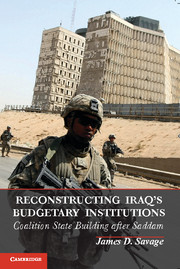Book contents
- Frontmatter
- Dedication
- Contents
- List of Tables
- List of Figures and Illustrations
- Preface
- Abbreviations
- 1 State Building and the Reconstruction of Iraq’s Budgetary Institutions
- 2 The Evolution of Iraqi Budgetary Institutions from the Ottomans and the British Mandate through Saddam
- 3 Prewar Planning for Iraq’s Economic and Budgetary Reconstruction
- 4 Boots on the Ground
- 5 Building Iraqi Ministerial Capacity
- 6 The 17th Benchmark and the Challenge of Iraqi Budget Execution
- 7 Building Iraqi Budgetary Capacity
- 8 Iraqi Budgeting
- 9 Successful State Building in Iraq?
- Bibliography
- Index
- References
1 - State Building and the Reconstruction of Iraq’s Budgetary Institutions
Published online by Cambridge University Press: 05 June 2014
- Frontmatter
- Dedication
- Contents
- List of Tables
- List of Figures and Illustrations
- Preface
- Abbreviations
- 1 State Building and the Reconstruction of Iraq’s Budgetary Institutions
- 2 The Evolution of Iraqi Budgetary Institutions from the Ottomans and the British Mandate through Saddam
- 3 Prewar Planning for Iraq’s Economic and Budgetary Reconstruction
- 4 Boots on the Ground
- 5 Building Iraqi Ministerial Capacity
- 6 The 17th Benchmark and the Challenge of Iraqi Budget Execution
- 7 Building Iraqi Budgetary Capacity
- 8 Iraqi Budgeting
- 9 Successful State Building in Iraq?
- Bibliography
- Index
- References
Summary
The fiscal history of a people is above all an essential part of its general history. . . . In some historical periods the immediate formative influence of the fiscal needs and policy of the state on the development of the economy and with it on all forms of life and all aspects of culture explains practically all the major features of events; in most periods it explains a great deal and there are but a few periods when it explains nothing. . . . Our people have become what they are under the fiscal pressures of the state.
Joseph A. SchumpeterOn Valentines’ Day 2007, President George W. Bush evaluated the political and economic progress taking place in Iraq by pointing to one significant accomplishment. “The other day,” Bush announced, “the Iraqi government passed a $41 billion budget, $10 billion of which is for reconstruction and capital investment. There’s a lot of talk in Washington about benchmarks. I agree – ‘benchmarks’ meaning that the Iraqi government said they’re going to do this; for example, have an oil law as a benchmark. But one of the benchmarks they laid out, besides committing troops to the Iraqi security plan, was that they’ll pass a budget in which there’s $10 billion of their own money available for reconstruction and help. And they met the benchmark. And now, obviously, it’s important they spend the money wisely.” Bush’s pronouncement on the status of Iraqi budgeting came at a time when Baghdad’s government and the American-led occupation verged on collapse, overcome by waves of violence that engulfed Iraq. Insurgents bombed the Golden Mosque of Samarra the preceding year, igniting sectarian assassinations, suicide attacks, and roadside bombings that killed as many as thirty-eight hundred Iraqis a week between September 2006 and January 2007, the pinnacle of civilian deaths experienced since the overthrow of Saddam Hussein. At that moment when the occupation appeared to be most vulnerable, Bush’s reference to the Parliament’s approval of the budget could be regarded as a desperate search for good news. Bush’s statement, however, reflected the reality that by 2007 the Coalition’s strategy for countering the violence and reconstructing the Iraqi state centered not only on a surge in American military forces but also on rebuilding the Iraqi government’s ability to budget.
- Type
- Chapter
- Information
- Reconstructing Iraq's Budgetary InstitutionsCoalition State Building after Saddam, pp. 1 - 24Publisher: Cambridge University PressPrint publication year: 2013



